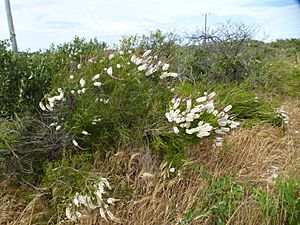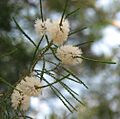Chenille honey-myrtle facts for kids
Quick facts for kids Chenille honey-myrtle |
|
|---|---|
 |
|
| Melaleuca huegelii growing near Ledge Point | |
| Scientific classification | |
| Genus: |
Melaleuca
|
| Species: |
huegelii
|
The Melaleuca huegelii, also known as chenille honey-myrtle, is a special plant. It belongs to the myrtle family called Myrtaceae. This plant is endemic to the south-west coast of Western Australia. This means it naturally grows only in this area. It has small, scale-like leaves. Its flower spikes can be over 100 mm (about 4 inches) long. These spikes grow on the ends of many branches.
Contents
What Does the Chenille Honey-Myrtle Look Like?
Melaleuca huegelii is usually a large shrub. Sometimes, it can grow into a small tree. It can reach up to 5 meters (about 16 feet) tall. This plant has dark bark. Its branches are often covered with fine, soft hairs, especially when they are young.
Leaves and Flowers
The leaves of this plant are small. They are about 1.3 to 10 mm (0.05 to 0.4 inches) long. They are also about 1 to 2.5 mm (0.04 to 0.1 inches) wide. Their shape is like a rough egg, and they get narrower to a point.
The flowers can be white, cream, or pink. They grow in spikes at the ends of the branches. These branches keep growing even after the flowers bloom. Sometimes, flowers also appear where the upper leaves meet the stem. The flower spikes can be very long, up to 100 mm (4 inches) or more. They are about 25 mm (1 inch) wide. Each spike can have up to 140 groups of three flowers. The petals are small, about 1.5 to 3 mm (0.06 to 0.1 inches) long. They fall off as the flowers get older.
Stamens and Fruit
Inside the flower, there are stamens. These are the parts that produce pollen. They are grouped into five bundles around the flower. Each bundle has 6 to 13 stamens. The plant usually flowers between August and January. After flowering, it produces fruit. These fruits are woody and shaped like a cup. They are about 2.3 to 2.8 mm (0.09 to 0.11 inches) long and wide. They grow in clusters along the stem.
How Did It Get Its Name?
The plant Melaleuca huegelii was first officially described in 1837. This was done by a person named Stephan Endlicher. He wrote about it in a book. The second part of its name, huegelii, honors Carl von Huegel. He was the one who collected the first sample of this plant. He found it growing near Fremantle in 1833.
Different Types of Chenille Honey-Myrtle
There are two slightly different types, or subspecies, of Melaleuca huegelii:
- Melaleuca huegelii subsp. huegelii: This type grows from the Walkaway area down to the Augusta area. It is found in several natural regions of Western Australia.
- Melaleuca huegelii subsp. pristicensis: This type grows in the Shark Bay area. The name pristicensis comes from an Ancient Greek word. Pristis means "shark," which refers to where this subspecies is found.
Where Does It Grow?
The Melaleuca huegelii plant grows along the coast of Western Australia. You can find it from the Shark Bay area all the way down to the Augusta area. It likes to grow in coastal places. This includes limestone cliffs, sand dunes, and flat plains near the sea.
Is It Protected?
The Government of Western Australia's Department of Parks and Wildlife says this species is "not threatened." This means it is not currently in danger of disappearing. However, one of its subspecies, pristicensis, is listed as "Priority Three." This means we don't know much about it. It is found in only a few places, but it is not in immediate danger.
Images for kids
-
Habit near Ledge Point





